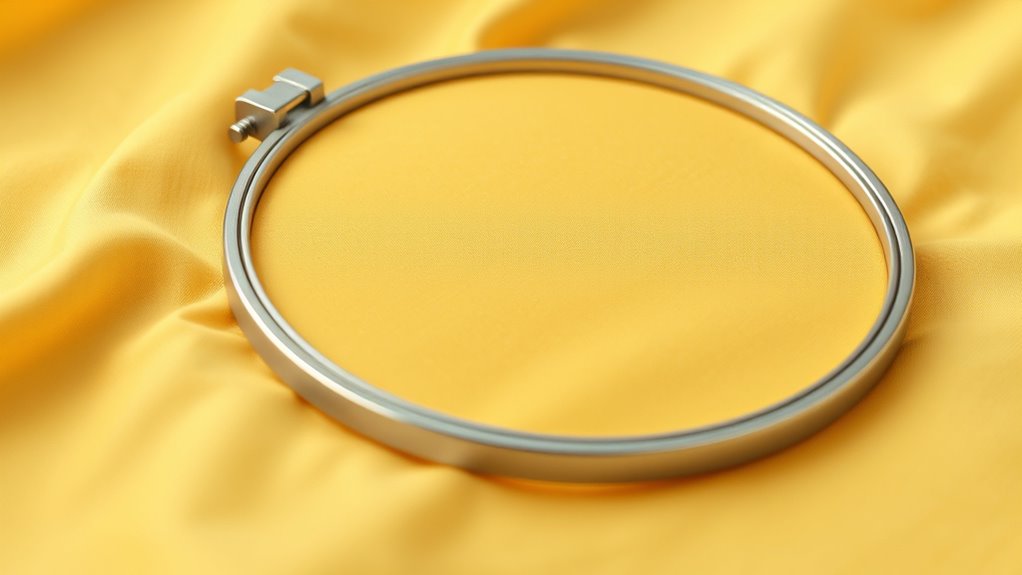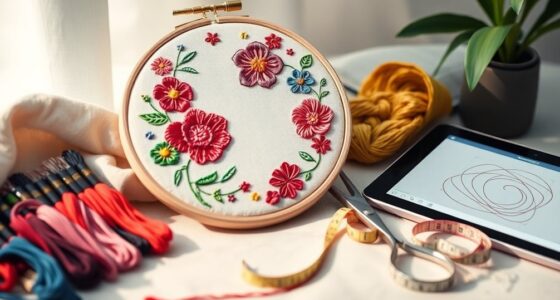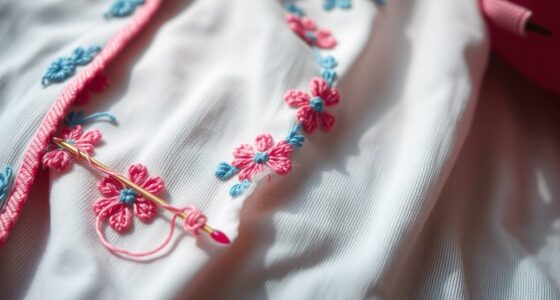To hoop fabric without slipping, first guarantee your hoop is clean and free of dust. Place the fabric over the inner hoop, centering and smoothing it out. Keep the fabric taut, then gradually tighten the outer hoop while pulling it tight to avoid slack. Check for any puckers or lifts and loosen slightly if needed. Maintaining even tension prevents shifting during stitching. If you want to master perfect hooping techniques, keep exploring the tips that follow.
Key Takeaways
- Ensure the hoop is clean and free of dust or lint before placing the fabric.
- Center the fabric over the inner hoop, smoothing out any wrinkles or slack.
- Gradually tighten the outer hoop while pulling fabric taut to maintain even tension.
- Check for puckering or lifting during tightening, loosening if necessary, then re-tighten.
- Maintain consistent tension throughout to prevent fabric slipping or shifting during embroidery.

Hooping fabric is an essential step in achieving precise and professional embroidery results. When you hoop fabric correctly, your designs will come out crisp, with minimal puckering or slipping. To do this effectively, you need to understand how to hoop fabric for embroidery properly and how to adjust hoop tension to keep everything secure. The key is to start with a clean, smooth piece of fabric and a properly selected hoop that fits your project. Make sure the hoop is clean and free of dust or lint, as these can cause slipping during stitching.
When hooping fabric for embroidery, you want to stretch the fabric tightly within the hoop. Tight tension keeps the fabric flat and prevents puckers or shifting. To achieve this, place your fabric over the inner hoop, ensuring it’s centered and smooth. Then, place the outer hoop on top and tighten it gradually. As you tighten, pull the fabric taut with your fingers or use a piece of scrunching or stretching technique to make sure there’s no slack. The goal is to have a firm, even tension across the entire surface, so the fabric doesn’t move during embroidery. Keep checking the fabric as you tighten—if it starts to pucker or lift, loosen the hoop slightly and reposition the fabric before re-tightening.
Adjusting hoop tension is essential for successful embroidery. Too tight, and you risk damaging the fabric or the hoop itself; too loose, and the fabric may shift or slip, ruining your design. If you notice slack or movement while stitching, it’s time to tweak the tension. Loosen the hoop slightly and pull the fabric more taut before re-tightening. Some hoops have tension screws that allow you to fine-tune this tension easily; others require manual adjustment by gripping and tightening with your hands. Consistent tension across the hoop ensures that the fabric stays firm and doesn’t shift as the needle penetrates. Additionally, understanding how to maintain consistent tension helps improve overall embroidery quality and prevents distortions in your designs.
Frequently Asked Questions
Can I Reuse the Hoop Fabric for Different Projects?
Yes, you can reuse hoop fabric for different projects, but it depends on how well you care for it. To maximize fabric reuse and hoop fabric longevity, handle it gently, wash it carefully, and avoid stretching or damaging the material. Inspect the fabric each time you reuse it, and replace it if it shows signs of wear or fraying. Proper maintenance guarantees your hoop fabric stays in good condition for multiple embroidery projects.
What Types of Fabric Are Best Suited for Hooping?
Did you know that woven textiles make up about 70% of embroidery projects? You should choose fabrics with minimal stretch to prevent slipping and puckering. Woven textiles like cotton and linen are ideal because they provide stability, making hooping easier. Avoid stretchy fabrics, as they tend to shift during embroidery, causing uneven stitches. Opt for these stable options for smooth, professional results every time.
How Do I Prevent Fabric Puckering During Hooping?
To prevent fabric puckering during hooping, you should focus on fabric stabilization and managing hoop tension. Make sure to lightly spray or use stabilizer to keep the fabric smooth and taut. Adjust the hoop tension so it’s firm but not overly tight, which prevents puckering. Always smooth out wrinkles before tightening, and double-check that the fabric is evenly tensioned for a clean, professional embroidery result.
Is There a Recommended Tension Level When Hooping Fabric?
You should aim for a medium tension level when hooping fabric, like gently tightening a jar lid. Adjust your tension so the fabric feels snug but not stretched tight—think of hooping pressure as a delicate balance. Use tension adjustment to evenly distribute pressure across the fabric, preventing puckering or slipping. The right tension keeps your embroidery smooth and secure, making your stitches flawless without any undue stress on the fabric.
How Often Should I Check Hooping Alignment During Embroidery?
You should check hooping alignment frequently during your embroidery project to maintain hooping consistency. Every few minutes, pause and verify that the fabric remains centered and taut, making small alignment adjustments if needed. This helps prevent slipping or uneven stitches, ensuring quality results. Regular checks keep your fabric stable, reduce errors, and give you confidence that your hooping remains correct throughout the entire embroidery process.
Conclusion
Mastering fabric hooping guarantees your embroidery stays flawless. Did you know that improper hooping can cause up to 60% of embroidery mistakes? By following these simple steps, you’ll reduce slipping and achieve professional-looking designs every time. Keep practicing, stay patient, and you’ll see your skills improve rapidly. Remember, a secure hoop is the foundation of beautiful embroidery—so don’t rush it. Your projects will turn out neater, and you’ll enjoy creating even more!









